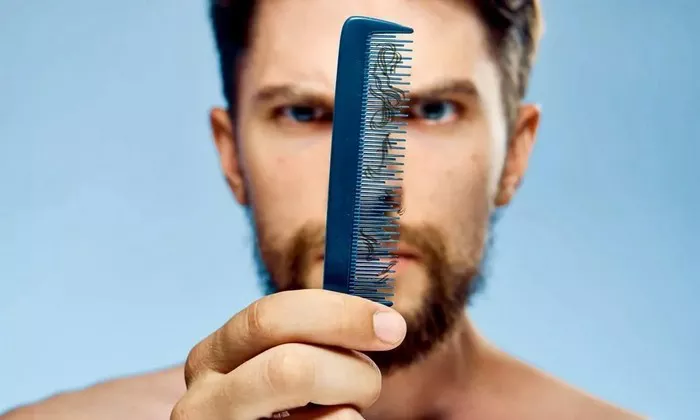Telogen effluvium (TE) is a condition characterized by excessive hair shedding triggered by stress or shock to the body. It occurs when a large number of hair follicles prematurely enter the resting (telogen) phase of the hair growth cycle, leading to noticeable reduction in hair volume. It is important to differentiate TE from androgenetic alopecia, which is genetic hair loss and follows a different pattern of hair thinning. Understanding the symptoms, treatment options, and duration of TE is crucial for effectively managing this condition.
Explanation of Telogen Effluvium (TE)
TE is a temporary form of hair loss that occurs due to various factors such as physical or emotional stress, hormonal changes, nutritional deficiencies, illness, or medication. When the body experiences stress or shock, it can disrupt the normal hair growth cycle, causing a larger number of hair follicles to enter the telogen phase prematurely.
During the telogen phase, hair follicles are in a resting state and eventually shed the hair shaft. In TE, the shedding of hair becomes noticeable as large amounts of hair are shed during routine activities such as washing or combing. Unlike androgenetic alopecia, which typically leads to gradual thinning of hair over time, TE results in sudden and excessive shedding, often affecting the overall volume and thickness of hair.
Common Symptoms of TE
The most common symptom of TE is a significant reduction in hair volume, often accompanied by increased shedding of hair during routine activities. Individuals with TE may notice more hair fall while washing, brushing, or styling their hair. Unlike androgenetic alopecia, which tends to affect specific areas of the scalp, TE can cause diffuse hair thinning across the entire scalp.
It is important to distinguish TE from other forms of hair loss, such as androgenetic alopecia, as the underlying causes and treatment approaches differ. While androgenetic alopecia is primarily influenced by genetic factors and hormonal imbalances, TE is often triggered by external stressors or changes in the body’s internal environment.
Treatment Options for TE
Fortunately, TE is usually temporary, and most individuals will experience regrowth of hair once the underlying cause is addressed. However, there are several treatment options available to help manage TE and promote faster recovery:
1. Minoxidil: Minoxidil is a topical solution commonly used to treat hair loss. It works by stimulating hair follicles and prolonging the growth phase of the hair cycle. For individuals with TE, a 5% minoxidil solution is often recommended. Men are advised to apply minoxidil twice daily, while women can apply it once daily to the affected areas of the scalp.
2. Low-level laser therapy (LLLT): LLLT is a non-invasive treatment that uses low-level laser light to stimulate hair follicles, improve blood circulation, and reduce inflammation in the scalp. The LC Elite Laser cap, equipped with 80 diodes, is a convenient option for individuals seeking LLLT treatment. It is recommended to use the laser cap twice weekly for shedding reduction and visible regrowth.
3. Platelet-rich plasma (PRP) therapy: PRP therapy involves injecting concentrated platelets from the patient’s own blood into the scalp to stimulate hair growth. PRP contains growth factors that promote hair follicle regeneration and tissue repair. In the case of TE, PRP injections can help slow down hair shedding and accelerate the regrowth process.
4. Topical melatonin: Melatonin, a hormone naturally produced by the body, has been shown to play a role in regulating the hair growth cycle. Topical melatonin formulations have been successful in halting hair shedding associated with TE when used in conjunction with other medical treatments. It can be applied directly to the scalp to promote hair growth and improve hair density.
5. Vitamin D3 supplementation: Vitamin D3 deficiency has been linked to stress-induced hair loss and may contribute to the development of TE. Adequate levels of vitamin D are essential for maintaining healthy hair follicles and promoting hair growth. Individuals with TE should have their vitamin D levels checked, and supplementation may be recommended if levels are low.
Duration and Recovery
TE typically lasts for one to six months, although the duration can vary depending on the underlying cause and individual factors. In most cases, hair shedding gradually subsides, and new hair growth begins within three to six months of onset. However, it may take up to 12 months for full recovery and restoration of hair volume.
Consistent treatment and management strategies are essential for promoting faster recovery from TE. This includes addressing any underlying medical conditions, managing stress levels, maintaining a healthy diet, and following a targeted treatment plan tailored to individual needs.
In conclusion, telogen effluvium is a reversible form of hair loss that is often triggered by stress or changes in the body’s internal environment. Understanding the symptoms, treatment options, and expected duration of TE is essential for effectively managing this condition and promoting hair regrowth. By utilizing appropriate treatment modalities and adopting healthy lifestyle practices, individuals experiencing TE can achieve restoration of hair volume and thickness over time.


